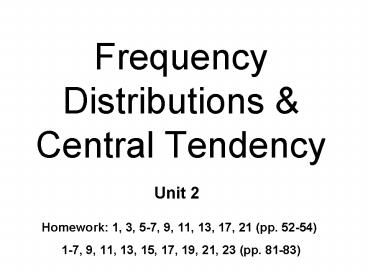Frequency Distributions - PowerPoint PPT Presentation
1 / 30
Title:
Frequency Distributions
Description:
2. Odd # entries median = middle value. 3. Even # entries = half way b/n middle 2 values ... modes. 10. 20. 30. 40. 50. 60. 70. 80. 90. X. f. median. mean ... – PowerPoint PPT presentation
Number of Views:38
Avg rating:3.0/5.0
Title: Frequency Distributions
1
Frequency Distributions Central Tendency
Unit 2
- Homework 1, 3, 5-7, 9, 11, 13, 17, 21 (pp.
52-54) 1-7, 9, 11, 13, 15, 17, 19, 21, 23 (pp.
81-83)
2
Organizing Data
- Describing distribution of variables
- enumeration list raw data
- Frequency distributions
- organize ---gt tables or graphs
- highlight important characteristics
- range, most frequent value
3
Distributions as Tables
- f Frequency
- of times a value of variable occurs
- Sf n
- calculate proportions percentages
- Tabular frequency distributions
- ordered list of all values of variable their
frequencies - logical order (usually descending)
4
Enumeration
of presentations to be able to recall 100
5
Grouped Frequency Distribution
- Group by class intervals
- report f for intervals
- Lose information exact values
- General rules
- each interval same width
- consecutive do not overlap
6
(No Transcript)
7
Distributions as graphs
- Summarizes data
- focus on clear communication
- see box 2.1 (p. 41)
- Bar Graphs
- nominal or ordinal data
- Histograms Frequency Polygons
- Interval/ratio data
- continuous discrete variables
8
Bar Graphs
Ordinal
Nominal
9
Histograms
- X-axis
- Class intervals of variables
- Y-axis
- Frequencies vertical bars
10
Frequency polygons
- Frequency represented as points
- Contains same info as histogram
f
11
Shapes of distributions
- Unimodal distribution
- single value is most frequent
- Bimodal
- 2 most frequently occurring values
- also multimodal
12
Symmetry of distributions
- Symmetric
- if right side mirror-image of left
- Skewed - asymmetric
- a few extreme values
- Positively skewed right tail longer
- Negatively skewed left tail longer
13
The Normal Distribution
- Bell-shaped
- 3 characteristics
- Unimodal
- symmetric
- asymptotic
- Characteristic of many distributions in nature
14
Measures of Central Tendency
15
3 essential characteristics of distributions
- Conveys most info for most distributions
- 1. Where is middle of distribution?
- 2. How wide is distribution?
- 3. What is shape of the distribution?
16
Central Tendency
- Describes middle of distribution
- Mode
- All levels of measurement
- Median
- ordinal interval/ratio only
- Mean
- interval/ratio only
17
Mode
- Most frequently occurring value
- appropriate for any measurement level
- nominal, ordinal, interval/ratio
18
Mode
- Most frequently occurring value
19
Median
- Midpoint of a data set
- values ½ smaller, ½ larger
20
Finding the Median
- 1. List all values from largest---gt smallest
- if f3, then list 3 times
- 2. Odd entries median middle value
- 3. Even entries half way b/n middle 2 values
21
Mean
- Average
- may not be actual value in data set
- Computing the mean
- statistic vs. parameter
Sample mean
22
Calculating Weighted Means
- Combining means from 2 or more samples
- If same number scores in each group
- n1 n2 n3 .. nn
- If n1 ? n2
23
Supplementary Material
24
Relative Frequency
- Frequencies represented as proportion or
percentage - Large of data points
- Larger sample size ---gt more intervals
- narrower bars ---gt smoother curve
25
Relative Frequency
f
of presentations
26
Relative Frequency
f
of presentations
27
10
20
30
40
50
60
70
80
90
28
positively skewed mode lt median lt mean
f
10
20
30
40
50
60
70
80
90
X
29
negatively skewed mode gt median gt mean
mode
30
Bimodal (symmetric) distribution?





























